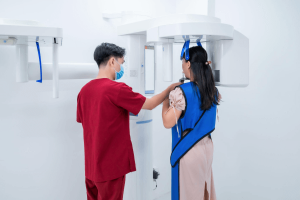Table of content
What is the wisdom tooth extraction process like? How long does it take? What should you pay attention to after wisdom tooth extraction? This is a question that many people are interested in when mentally preparing to “handle” the last tooth to grow. Please refer to the article below to find out the answer!
1. How does the wisdom tooth extraction process take place?
Normally, the process of extracting tooth number 8 (wisdom tooth) is performed with the following four steps:
Step 1: X-ray and Consultation with the Dentist
This is the first important step in the wisdom tooth extraction process. X-rays provide accurate imaging data on the position of the wisdom tooth growing, helping the doctor clearly understand and evaluate the current situation to develop a suitable, safe, and less expensive tooth extraction plan shock the patient.
View more: Does Wisdom Teething hurt? Notes to know

Step 2: Blood test
The patient is prescribed a blood test to check the blood clotting status. If there is a problem, the doctor will immediately use interventional medication to ensure the wisdom tooth extraction process goes smoothly without affecting your health. In addition, patients are also tested for diabetes, cardiovascular disease, or high blood pressure, to eliminate risk factors and ensure safety after treatment.
Step 3: Proceed to extract wisdom teeth
The doctor performs local anesthesia so that the patient has a gentle and comfortable experience, without feeling pain during the wisdom tooth extraction process. Especially before the procedure, the clinic must also ensure sterilization of tools to limit cross-infection to patients.
Step 4: Follow-up Examination
After the wisdom tooth extraction process, the patient is instructed by the doctor on proper eating and hygiene practices and also makes an appointment to return to the clinic to have the wound checked. Especially within 7 – 10 days after extraction, if you feel any problems, quickly contact the clinic for timely assistance.
View more: Is Wisdom Tooth Extraction risky? Some potential complications to be aware of
2. Pay attention before and after wisdom tooth extraction
In order for the tooth extraction process to take place safely and without leaving dangerous complications, the patient must pay attention to issues before and after the procedure, such as:
2.1. Before wisdom tooth extraction
Wisdom tooth extraction is considered a form of minor dental surgery. Therefore, in order for the wisdom tooth extraction process to go smoothly, with as little swelling and pain as possible, patients should take note of the following:
- If you are using any medication or have a medical history, especially if you have blood pressure, heart disease, diabetes, or hemophilia, please notify your doctor before removing your wisdom teeth.
- If you have a fever, cough, or flu, you should wait until your health is completely stable before proceeding with wisdom tooth extraction.
- Clean oral hygiene, have had tartar removed and treated for gingivitis (if any) before.
- Women who are in their menstrual cycle or pregnant should not have their wisdom teeth extracted at this time.
View more: Is Wisdom Tooth Extraction painful? Pain-Free Methods to consider
2.2. After wisdom tooth extraction
After wisdom tooth extraction, swelling, pain, and bleeding are some common symptoms. However, patients should not worry too much because the above condition can typically resolve after 1-2 days. To minimize discomfort, you should do some of the following:
- Within the first 30 minutes after tooth extraction, you should bite the cotton ball tightly to limit bleeding. During the next 24 – 48 hours, blood may occur slightly and mix with saliva to form a pink solution. This is a completely normal symptom. In case there is still heavy bleeding, the patient should immediately contact the dental center to report the situation.
- When the anesthetic wears off, the patient may feel slight pain. Use the medicine according to your doctor’s instructions to feel more comfortable.
- In cases where teeth are difficult to grow, swelling may appear in the first 1-2 days and make it difficult for the patient to eat and chew. At this time, choose liquid, soft foods such as porridge or cooled soup. If after 5 days, swelling increases with pain, the patient should immediately contact a doctor for treatment assistance.
View more: Post-Wisdom Teeth Removal: Foods to eat and avoid

After wisdom tooth extraction, a hole may appear in the extraction area because there is no longer a tooth root embedded in the bone. Depending on each individual’s physiology, the holes/holes are filled within 1 – 2 months.
Therefore, at this stage, to prevent food from getting stuck in the hole and causing tooth decay, patients should use a soft toothbrush to clean their teeth regularly, combined with mouthwash to help food wash out. Be careful not to use toothpicks or sharp objects to get food because this causes bleeding, and infection and affects the healing process.
3. Some frequently asked questions about the wisdom tooth extraction process
Below are questions related to the tooth extraction process number 8 that many people are interested in:
3.1. How long does wisdom tooth extraction take?
Determining how long it takes to remove wisdom teeth depends on the complexity and growth position of the teeth. If your wisdom teeth are easily accessible and straightforward to extract, the doctor will only take 15 – 20 minutes for one tooth. On the contrary, for the procedure of removing misaligned or impacted wisdom teeth, the time may be longer, lasting 30 – 60 minutes.
3.2. How is the wisdom tooth extraction process different from regular teeth?
For normal teeth, the doctor only needs to loosen the tooth root, then use pliers and pull gently to quickly extract the tooth. However, in the case of wisdom teeth, the process can be more complex. Due to some cases of wisdom teeth growing crookedly, with many roots and large roots, the doctor must make a small incision and cut the roots into small pieces to be able to extract the tooth.
Thus, wisdom tooth extraction is often complicated, and difficult and takes more time than regular tooth extraction. This is also the only difference between the two processes.
3.3. Is tooth extraction of wisdom tooth painful? When will the swelling go away?
After wisdom tooth extraction, patients may experience pain and swelling in the treatment area. This is a normal reaction of the body when the gums are affected, so you don’t have to worry too much.
Usually, the pain symptoms disappear on their own about a week later, but if the pain persists without improvement, accompanied by signs of increased swelling, fever, or development of a lump, the patient should see a doctor for support.
Through the information above, we hope the patient has a clear understanding of how the wisdom tooth extraction process takes place, including several steps to better prepare mentally. In general, wisdom tooth extraction is a complex dental treatment, especially in cases where the tooth grows in a difficult position or grows underground in the gums. If not handled by an experienced doctor, it can lead to serious complications, causing the patient severe pain and swelling, and taking longer to heal.
This is also the reason why tooth extraction procedure number 8 must be performed at a reputable address, to ensure safety, as well as a gentle experience for the patient.
Safe and gentle wisdom tooth extraction process at Elite Dental
Currently, Elite Dental is one of the leading dental centers, with its own minor surgery department and a team of highly professional doctors, contributing to a safe, gentle, and least painful wisdom tooth extraction process possible.
Besides, the modern equipment system also plays a significant role, helping the tooth extraction process number 8 go smoothly and speed up the healing speed. At Elite Dental, patients undergo X-rays using state-of-the-art imaging machines imported from Germany for accurate image results, helping the Doctor to easily plan tooth extraction.
In particular, Elite also has a Piezotome machine to help reduce trauma during the wisdom tooth extraction process, along with PRP technology to reduce pain and swelling and promote faster healing. As a result, patients have a smooth and gentle tooth extraction journey. and safe. If you have any questions, do not hesitate to contact Elite Dental for quick and detailed advice!
Related posts: > Discover a reliable dental clinic for Wisdom Tooth Extraction in Ho Chi Minh City > Is It okay for Wisdom Teeth to grow misaligned or impacted? How to manage It > 9 Wisdom Tooth Extraction tips most people don’t know







